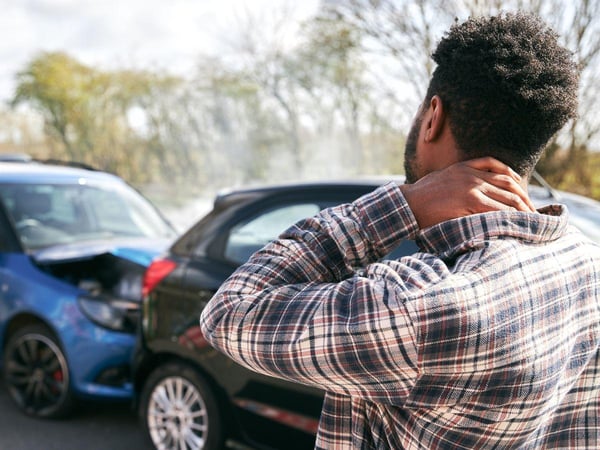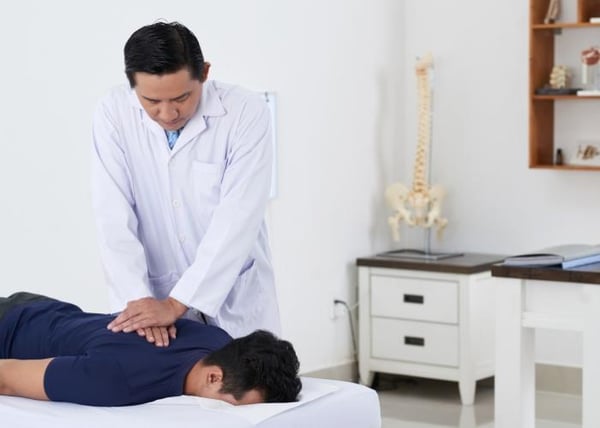Key Takeaways:
- Variety of Injuries: Rear-end collisions can result in a diverse range of injuries, from whiplash and spinal damage to soft tissue injuries, highlighting the need for comprehensive medical assessment following accidents.
- Importance of Chiropractic Care: Immediate chiropractic intervention after a rear-end collision can significantly enhance recovery outcomes and aid in documenting injuries for insurance claims.
- Legal and Insurance Guidance: Efficiently navigating insurance claims and legal processes with professional assistance ensures adequate compensation for damages and injuries sustained in rear-end collisions.
Rear-end car accidents are among the most common types of vehicle accidents, often leading to a wide range of injuries.
Below, we will explore the typical injuries sustained in rear-end collisions, like whiplash, spinal injuries, and soft tissue damages and the contributing factors of these accidents.
Whether you're dealing with neck pain, spinal discomfort, or more severe conditions like traumatic brain injury and spinal cord trauma, understanding the impact of these accidents and receiving proper medical care is crucial.
Table of Contents
- Injuries In Rear-End Vehicle Crashes
- Important Factors That Contribute To Rear-End Accidents
- Vehicle Damage After A Rear-End Collision
- Navigating Insurance and Compensation
- The Crucial Role of Chiropractic Care After a Rear-End Collision
- Choose Arrowhead Clinic for Your Auto Accident Injury Treatments
Injuries In Rear-End Vehicle Crashes
In rear-end vehicle crashes, the rapid forces exerted on the body can lead to a variety of severe and complex injuries.
Some of these injuries are immediately noticeable, but others have delayed symptoms.
Whiplash is the most commonly recognized injury, occurring when sudden head movement strains the neck muscles and spine.
This jerking motion can also lead to spinal injuries and even traumatic brain injuries (TBI) if the head impacts the steering wheel or headrest. Symptoms of TBI include loss of consciousness, confusion, and cognitive difficulties, which may emerge days after the incident.
Common injuries from rear-end vehicle crashes include:
- Whiplash: Neck strain from the head's sudden forward and backward movement.
- Spinal Injuries: Damage to the spine, which can range from mild strain to severe spinal cord trauma.
- Traumatic Brain Injuries: Impact injuries to the head that can lead to long-term cognitive issues.
- Facial Scarring: Injuries from the airbag, broken glass, or dashboard leading to cuts or burns.
- Fractures: Breaks commonly occur in the fingers, feet, ribs, and spine due to the body bracing for impact.
- Paralysis: Severe trauma to the spine leading to partial or total loss of motor function.
- Back Injuries: Damage due to the rapid forward and backward motion experienced during the crash.
Immediate medical attention is essential after experiencing a rear-end collision to address any injuries and begin the recovery process.
Medical treatments can range from physical therapy for less severe injuries to surgical interventions for serious conditions.
Victims are also advised to consider legal consultation to ensure compensation for medical expenses, lost wages, and pain and suffering due to the accident.
Understanding the broad range of potential injuries and necessary steps for medical care is vital for any rear-end accident victim.

Important Factors That Contribute To Rear-End Accidents
Several factors can significantly influence the severity and occurrence of rear-end accidents.
First, vehicle characteristics, such as the weight and speed differential between the vehicles involved, play a crucial role in determining the force of the impact.
The location and direction of impact also determine how the force is absorbed and distributed, potentially increasing damage and injury risk.
The importance of safety features, such as head restraints, is undeniable.
If set too low, they can cause the head to hyperextend over the top, worsening neck injuries.
Equally important is the occupants' head position at impact.
A head turned to the side, for instance, can lead to uneven force distribution across the neck.
But it's not just technology that matters.
The response of passengers will also influence the type of injuries sustained.
For example, injuries sustained from tensing up when an occupant is aware of an impending crash differ from those in unexpected collisions.
Research has shown that the position of passengers is crucial in rear-end collisions.
For instance, in collisions at speeds up to 15mph, the right front seat passenger may face a higher risk of injury than the driver, who can brace themselves to a certain extent by holding onto the steering wheel.
This highlights the need for individual responsibility in safety and the importance of understanding these factors for assessing safety measures and the impacts of rear-end collisions.
Vehicle Damage After A Rear-End Collision
After a rear-end collision, it's crucial to look for visible and hidden damages to your vehicle, which might not be immediately apparent.
Here are some key areas to check:
- Hidden Auto Collision Damage: At first glance, a vehicle may appear undamaged, but even minor collisions can cause internal damage to the frame behind the bumper. Although the bumper may not display visible damage, it may still hide significant structural issues. It never hurts to examine your vehicle thoroughly to uncover any potential hidden damage.
- Trunk Damage: Damage to the trunk is a common result of rear-end collisions. While it might not impair driving directly, a compromised trunk can pose safety risks. For example, it could suddenly open while driving, which could obstruct your view or cause more accidents. Check if the trunk closes and locks securely.
- Alignment Problems: Misalignment can significantly affect the vehicle's handling post-collision. Signs of alignment issues include the car pulling to one side, uneven tire wear, or unusual vibrations during driving. This can degrade the driving experience and increase wear and tear on your vehicle. If you notice any of these symptoms, it is important to have your vehicle's alignment checked and corrected if necessary.
These checks are essential for the safety and longevity of your vehicle and for maintaining its value and ensuring it functions properly after an accident.
Addressing these issues promptly with a qualified technician can help prevent more severe problems down the road.
Navigating Insurance and Compensation
Navigating the aftermath of a rear-end collision involves crucial interactions with insurance companies to secure necessary financial compensation.
Understanding how to deal with insurance adjusters can ensure maximum compensation for damages like medical bills, lost wages, and even non-economic damages such as emotional distress.
It's essential to document all accident-related injuries meticulously, maintaining records of medical consultations and treatments related to spinal injuries, whiplash, or any chronic pain that arises.
Engaging a skilled personal injury lawyer can significantly enhance your ability to negotiate effectively with insurance companies.
Personal injury attorneys are experienced in dealing with tactics that insurance companies might use to minimize payout and can help accident victims understand fault insurance laws and potential compensatory and punitive damages.
For a successful claim, it's crucial to start the process early and provide detailed evidence of all injuries and expenses incurred.
This proactive approach facilitates a smoother legal process and ensures that you are justly compensated for both tangible and intangible losses from rear-end collisions.

The Crucial Role of Chiropractic Care After a Rear-End Collision
Chiropractic care is crucial after a rear-end collision as it provides necessary treatment for various injuries that can occur in these accidents. Chiropractors specialize in spinal and soft tissue injuries, which are common in rear-end crashes.
They help restore range of motion and alleviate symptoms of whiplash injury, spinal fractures, herniated discs, and muscle strains.
Chiropractic treatments like manual therapy and spinal decompression therapy can significantly aid in the recovery of spinal cord injuries and severe neck pain, often without the need for invasive surgeries.
Immediate chiropractic care assists in physical recovery and plays a pivotal role in supporting insurance claims.
Documenting the extent of spinal and soft tissue injuries through a licensed chiropractor can provide solid evidence of accident injuries, enhancing the credibility of claims for financial compensation.
This medical documentation is essential when working with personal injury lawyers to ensure that insurance companies recognize and compensate medical treatments appropriately.
Engaging with chiropractic care soon after an accident helps mitigate long-term damage and ensures that health and legal aspects are addressed promptly, improving the overall outcome of recovery and claims.
Choose Arrowhead Clinic for Your Auto Accident Injury Treatments
Throughout this article, we've examined the potential injuries from rear-end car accidents, emphasizing the importance of proper medical evaluation and treatment.
Arrowhead Clinic specializes in providing comprehensive chiropractic care for injuries like whiplash, spinal cord damage, and other soft tissue injuries typically associated with these collisions.
To support your recovery, Arrowhead Clinic provides free consultations and custom treatment plans tailored to your specific needs.
Take the first step towards your recovery by scheduling a free consultation with Arrowhead Clinic today.
Don't let accident injuries dictate your life—get the expert care you need to heal and regain your quality of life.
Click below to learn more and book your free consultation.



